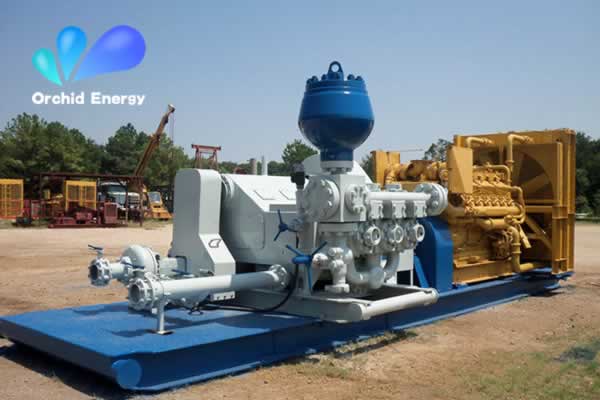Exploring the Mud Pump: A Pivotal Component in Drilling Operations
Abstract:
Mud pumps are crucial components in drilling operations, playing a pivotal role in circulating drilling mud and ensuring efficient and safe drilling. This comprehensive article aims to provide a detailed introduction to mud pumps, covering their functionality, key components, and applications.
Table of Contents:
1. Introduction
2. The Role of Mud Pumps in Drilling Operations
3. Components of Mud Pumps
3.1. Power End Components
3.2. Fluid End Components
4. Mud Pump Types and Classification
4.1. Triplex Mud Pumps
4.2. Duplex Mud Pumps
4.3. Single-Acting Mud Pumps
4.4. Double-Acting Mud Pumps
5. Benefits and Applications of Mud Pumps
6. Comparison Table: Mud Pump Types and their Features
7. Further Considerations in Mud Pump Selection
8. Emerging Technologies in Mud Pump Design
9. Conclusion

1. Introduction
Mud pumps are essential equipment in drilling operations, enabling the circulation of drilling fluid or mud. They serve multiple purposes, such as lubricating the drill bit, carrying drill cuttings to the surface, and maintaining pressure control in the wellbore. This article provides a comprehensive overview of mud pumps, shedding light on their functionality, components, types, and applications.
2. The Role of Mud Pumps in Drilling Operations
Mud pumps facilitate the continuous circulation of drilling mud, creating a closed-loop system that carries out crucial tasks during drilling. These include cooling and lubricating the drill bit, flushing away debris and cuttings, and maintaining hydrostatic pressure to prevent blowouts. Mud pumps also aid in stabilizing the wellbore and evaluating formations encountered during drilling.
3. Components of Mud Pumps
3.1. Power End Components:
-
Prime Mover: Electric motor or diesel engine.
-
Transmission System: Transmits energy from the prime mover to the fluid end.
3.2. Fluid End Components:
-
Pistons or Plungers: Generate reciprocating motion to create high-pressure flow.
-
Valves: Suction and discharge valves ensure unidirectional flow.
-
Liner: Protects against corrosion and abrasion caused by drilling fluid.
-
Crosshead: Transmits reciprocating motion from the power end to the fluid end.
4. Mud Pump Types and Classification
Various types of mud pumps exist, including:
-
Triplex Mud Pumps: Most common due to their high pressure and flow rate capabilities.
-
Duplex Mud Pumps: Suited for low-pressure applications.
-
Single-Acting Mud Pumps: Use only one side of the piston or plunger.
-
Double-Acting Mud Pumps: Use both sides of the piston or plunger for enhanced efficiency.
5. Benefits and Applications of Mud Pumps
-
Ensures continuous circulation of drilling fluid for efficient cooling and lubrication.
-
Facilitates cuttings removal and wellbore stability.
-
Provides pressure control to prevent blowouts.
-
Enables formation evaluation to assess reservoir properties.
6. Comparison Table: Mud Pump Types and their Features
|
Mud Pump Type
|
Pressure Rating
|
Flow Rate Capability
|
Suitable Applications
|
|
Triplex Mud Pumps
|
High
|
High
|
Oil and Gas Exploration, Geothermal Drilling, Mining
|
|
Duplex Mud Pumps
|
Low
|
Moderate
|
Water Well Drilling, Small-Scale Operations
|
|
Single-Acting
|
Moderate
|
Moderate to High
|
Offshore Drilling, Water Well Drilling
|
|
Double-Acting
|
High
|
High
|
Large-Scale Drilling Operations, Enhanced Efficiency
|
7. Further Considerations in Mud Pump Selection
When selecting a mud pump for a specific drilling operation, several factors should be taken into account:
7.1. Operating Pressure and Flow Rate Requirements:
The pressure rating and flow rate capability of mud pumps should align with the drilling operation's demands. High-pressure and high-flow pumps, such as triplex mud pumps, are typically preferred for oil and gas exploration, geothermal drilling, and mining. Conversely, low-pressure pumps like duplex mud pumps are suitable for water well drilling and small-scale operations.
7.2. Power Source:
Consider the availability and suitability of power sources like electric motors or diesel engines. Electrically driven mud pumps are commonly used in onshore drilling operations, where a stable power supply is accessible. Diesel-powered mud pumps are advantageous in remote areas or offshore drilling platforms.
7.3. Maintenance and Durability:
Evaluate the durability and ease of maintenance for different mud pump models. Components such as liners, valves, and pistons are subject to wear and tear due to the abrasive nature of drilling fluids. Opting for mud pumps with easily replaceable and readily available spare parts can minimize downtime and maintenance costs.
7.4. Space and Weight Constraints:
Drilling rigs may have limited space and weight capacities. Ensure the mud pump dimensions and weight are compatible with the rig's specifications. Compact and lightweight mud pump models are preferable for offshore drilling and mobile drilling units.
7.5. Environmental Considerations:
Drilling activities must comply with environmental regulations. Select mud pumps that minimize fluid leakage and emissions, reducing the ecological impact. Additionally, consider mud pump features that support efficient waste management, such as integrated solids control systems.
8. Emerging Technologies in Mud Pump Design
Advancements in technology continue to enhance mud pump capabilities and efficiency. Some notable developments include:
8.1. Variable Frequency Drives (VFD):
VFD systems enable operators to optimize mud pump performance by adjusting pump speed and power consumption based on the drilling requirements. This feature enhances energy efficiency and reduces wear on components.
8.2. Automated Control Systems:
Integrated control systems enable remote monitoring and control of mud pump operations, improving safety and operational efficiency. These systems can include features such as real-time diagnostics, predictive maintenance, and automated alarms.
8.3. Advanced Materials and Coatings:
Innovative materials and coatings can enhance the durability and corrosion resistance of mud pump components. For example, the use of ceramic liners and advanced metallurgy can improve wear resistance, extending service life.
9. Conclusion
Mud pumps are crucial components in drilling operations, ensuring efficient circulation of drilling fluid and maintaining wellbore stability. By considering factors such as pressure and flow rate requirements, power sources, maintenance needs, and environmental considerations, operators can select the most suitable mud pump for their specific drilling applications. Continued advancements in mud pump technology promise future improvements in efficiency, automation, and environmental impact, further enhancing drilling operations worldwide.
Tags: Mud Pump
The mud pump plays a critical role in drilling operations across various industries, including oil and gas exploration, geothermal drilling, and mining. It serves as a vital component in circulating drilling mud, which is essential for efficient and safe drilling.
2023-08-16




